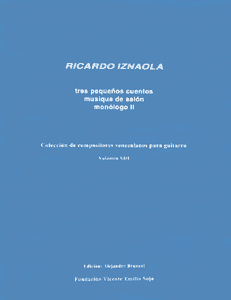
 |
|
 |

| Publication Info |
| SCORE |
$11.00 + shipping & handling |
|
|
| About this Item |
Tres pequeños cuentos (Three Little Tales): These miniatures, written with a didactic purpose, are inspired in three situations drawn from the traditional mythology of the fairy tale: Tom-O’Thumb, lost in the shadowy and threatening forest, trusts in finding the return path home by following the traces of his bread crumbs, only to find the mocking, ironic bird-song of the same little birds that, in other circumstances, might have made joyful his day of adventures. The work is an essay in syncopated rhythms and, technically, demands right hand flexibility to cope with the alternation of repeated chords with arpeggiated textures. Dragonslayer confronts the medieval hero (perhaps St. George?) with the diabolical fire serpent that, obsessively, persists in its attack only to surrender, at last, to the imperturbable courage of the saintly man. The piece is a study in slurred scales. Alice’s Rhumba transforms the land of wonders into an environment of coconut and banana trees that lends its exuberance to the folk, until it all culminates in a wild party that awakens the tropical and scarcely Anglo-Saxon Alice. The piece requires agility and precision in left-hand shifting, while utilizing a unique arpeggio formula.
This little suite was written in 1995 and dedicated to the three children of the great Anglo-Turkish composer/guitarist Gilbert Biberian.
Musique de Salon (Suite No. 5): Musique de Salon pays homage to the end of the century… the XIX century.
As we reach the last threshold of our own century, the bitterest, cruelest in history according to many, we look back with nostalgia at a time when optimism and hope still reigned supreme, only to be shattered by the era of Hitler and Stalin, by two World Wars, and the unimaginable suffering that destroyed the wondrous joie de vivre which characterized the period between 1895 and 1914, known as la Belle Epoque. We, also, feel a bit of optimism about the next hundred years, if for nothing else, in the desire to see an end to the madness that has engulfed our time.
And so this suite has no more ambition but to recapture, in some measure and with a few twists, the spirit materialized in the Parisian end-of-the-century salon where friends gathered to share the good times making music, in an intimate atmosphere of beauty, elegance and wit. The style avoids the strident compositional tools of the XX century and evokes instead the flavor of the Modernists, Impressionists and post-Romantics, Debussy, Scriabin, Ravel…
A hint of sadness transpires at moments. It speaks not of tragedy but of that sweet melancholy in which we indulge when we reminisce of past moments of joy no longer available to us. Victor Hugo defined this emotion as “the pleasure of being sad.”
This version of the suite, for solo guitar, was, despite its number, the first of five versions that, with diverse movements, also exist for guitar duo, guitar and string orchestra, and two versions for guitar with various instruments. Although the solo guitar version was composed in 1975, it has been recently revised.
Monólogo II (Monologue II): Written in 1982, Monologue II is a spiritual, though not stylistic sequel of the Monologue for solo double bass of 1978. The work’s narrative uses elements of Afro-Cuban music, including textual citations, distorted though easily recognizable, of the Son de la Loma by the great Cuban ‘sonero’ Miguel Matamoros. Bimodality, quasi-minimalist ostinatos and tonal ambiguity are framed within a clearly tonal structure, though the coloration of chromaticism and dissonance is characteristic. The work develops in an ample movement articulated in four sections, differentiated by tempo and texture: Entrada, Ostinato, Parafrasis and Coda.
The piece was an award-winning entry in the 1983 Stroud International Composers Competition, in England, and is the basis for the Concerto for Guitar and Orchestra, Tiempo Muerto, of 1997. It is dedicated “to my sister, in search of the lost ‘son’ ” and wants to be a personal and subjective statement about the situation of uprooted-ness affecting thousands of Cubans inside and outside the island, separated from family and community by historical circumstances still begging for resolution.
Ricardo Iznaola, 1999
| Notes & Credits |